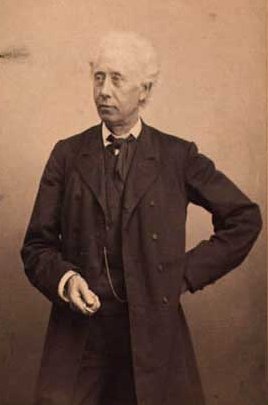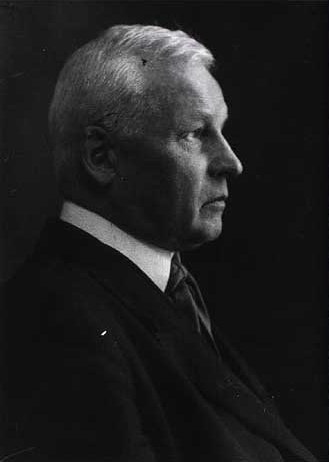|
H. C. Ørsteds Vej
H. C. Ørsteds Vej is a street in the Frederiksberg district of Copenhagen, Denmark. It runs from Gammel Kongevej in the south to Åboulevard on the border with Nørrebro in the north, linking Alhambravej in the south with Griffenfeldsgade in the north. History The oldest section of the street, between Amalievej and Fuglevangsvej, was created and named in 1852. The section from Fuglevangsvej and Åboulevard (then Vinkelvej) was created in 1857, This new section of the street was originally called Jernbanevej since it was crossed by the tracks of the Nordbanen and Copenhagen–Fredericia/Taulov Line railway lines which split at Ladegårdsåen. Jernbanevej was included in H. C. Ørstedsvej in 1870. Henning Wolf's masterplan for Frederiksberg Villa Quarter, a neighbourhood of single-family detached homes in the area north of Gammel Kongevej, it involved an extension of Jernbanevej to Gammel Kongevej. Other elements in Wolf's masterplan were the extension of Kastanievej to H. C. Ør ... [...More Info...] [...Related Items...] OR: [Wikipedia] [Google] [Baidu] |
Copenhagen
Copenhagen ( or .; da, København ) is the capital and most populous city of Denmark, with a proper population of around 815.000 in the last quarter of 2022; and some 1.370,000 in the urban area; and the wider Copenhagen metropolitan area has 2,057,142 people. Copenhagen is on the islands of Zealand and Amager, separated from Malmö, Sweden, by the Øresund strait. The Øresund Bridge connects the two cities by rail and road. Originally a Viking fishing village established in the 10th century in the vicinity of what is now Gammel Strand, Copenhagen became the capital of Denmark in the early 15th century. Beginning in the 17th century, it consolidated its position as a regional centre of power with its institutions, defences, and armed forces. During the Renaissance the city served as the de facto capital of the Kalmar Union, being the seat of monarchy, governing the majority of the present day Nordic region in a personal union with Sweden and Norway ruled by the Danis ... [...More Info...] [...Related Items...] OR: [Wikipedia] [Google] [Baidu] |
Forhåbningsholms Allé
Forhåbningsholms Allé is a street in the Frederiksberg district of Copenhagen, Denmark. It runs from Gammel Kongevej in the south to Niels Ebbesens Vej in the north. Notable buildings in the street include the Immanuel Church from 1893 (No. 20A) and the former country house Forhåbningsholm (No. 23) for which the street is named. History The merchant Henning Frederik Bargum bought a piece of land and constructed the country house Forhåbningsholm at the site in 1765. Bargum was that same year a driving force behind the establishment of Det danske Guineiske Kompagni. On 18 March 1765, he was granted a 20-year monopoly on slave trade from the Danish Gold Coast and on 1 November that same year a royal concession on the fortresses of Christiansborg and Fredensborg. The business plan was to purchase gold, ivory, and slaves on the Danish Gold Coast, then sell the slaves in the Danish West Indies and return with raw sugar to Denmark. Three ships were initially acquired of which t ... [...More Info...] [...Related Items...] OR: [Wikipedia] [Google] [Baidu] |
Peter Lange-Müller
Peter Erasmus Lange-Müller (1 December 1850 – 26 February 1926) was a Danish composer and pianist. His compositional style was influenced by Danish folk music and by the work of Robert Schumann; Johannes Brahms; and his Danish countrymen, including J.P.E. Hartmann. Early years Lange-Müller was born in Frederiksberg, Denmark to an affluent family with a background in politics. He spent his childhood painting, reading poetry, and studying music with prominent teachers, including G. Matthison-Hansen. Poor health prevented him from attending school until 1871, when he entered conservatory to study composition. After a year, however, his father decided that he should follow his professional path and enrolled him in Copenhagen University to study political science. He was not suited for a life in politics though, and by 1874 he had become fully immersed in his compositional career. It was at this time that he and several colleagues founded Copenhagen's Concert Society. Middle years ... [...More Info...] [...Related Items...] OR: [Wikipedia] [Google] [Baidu] |
Johannes Helms
Johannes Helms (8 November 1828 – 4 December 1895) was a Danish writer and schoolmaster who experienced the Three Years' War firsthand. Biography Helms was born in the rectory of Sørbymagle County. His father, Søren Bagger Helms (1788–1872), was the local rector and his mother, Nicoline Marie Zeuthen (1789–1870), was her husband's second wife. Four of the couples sons were present in Schleswig-Holstein during the battles in 1864 and subsequently published their experiences. He graduated from Frederiksborg Gymnasium in 1847 and continued onto Philology at the University of Copenhagen that same year. At the time he was a member of the (a military unit made up of university students and a de facto competitor/substitute for the Copenhagen police). In March 1850 he joined the Danish army partaking in the nationalistic frenzy erupting in those months. He was promoted to (sergeant) before the Battle of Fredericia and received the Silver Cross for his actions there. He retur ... [...More Info...] [...Related Items...] OR: [Wikipedia] [Google] [Baidu] |
Carl Aller
Carl Julius Aller (25 November 1845 - 23 August 1926) was a Danish publisher of the late 19th and early 20th century and founder of Aller Media, the largest publisher of weekly magazines in the Nordic countries and still controlled by the Aller family. Early life and education Carl Aller was born in Copenhagen on 25 November 1845, the son of brewer Christian Hansen Aller (1797–1852) and Juliane Christine Geschel el. Gechel (ca. 1806–72). He apprenticed as a lithographer in C. F. Aamodt's studio. Career In am early age, Aller invented a new photolithographic method of image production. In 1869, he was awarded the Ørsted Grant for his invention. Together with his wife, Laura Aller, he founded Carl Aller's Etablissement in 1873 and in 1874 they began the publication of ''Nordisk Mønster Tidende'' (later Femina). In 1877, they launched a new magazine '' Illustrated Family Journal'' (Danish: Illustreret Familie Journal), with Laura Aller as editor-in-chief. The magazine expe ... [...More Info...] [...Related Items...] OR: [Wikipedia] [Google] [Baidu] |
Frederiksberg Allé Station
Frederiksberg () is a part of the Capital Region of Denmark. It is formally an independent municipality, Frederiksberg Municipality, separate from Copenhagen Municipality, but both are a part of the City of Copenhagen. It occupies an area of less than 9 km2 and had a population of 103,192 in 2015. Frederiksberg is an enclave surrounded by Copenhagen Municipality. Some sources ambiguously refer to Frederiksberg as a quarter or neighbourhood of Copenhagen, being one of the four municipalities that constitute the City of Copenhagen (the other three being Copenhagen, Tårnby and Dragør). However, Frederiksberg has its own mayor and municipal council, and is fiercely independent. Frederiksberg is an affluent area, characterised by its many green spaces such as the Frederiksberg Gardens, Søndermarken, and Hostrups Have. Some institutions and locations that are widely considered to be part of Copenhagen are actually located in Frederiksberg. For example, Copenhagen Zoo as w ... [...More Info...] [...Related Items...] OR: [Wikipedia] [Google] [Baidu] |
Copenhagen Metro
The Copenhagen Metro ( da, Københavns Metro, ) is a 24/7 rapid transit system in Copenhagen, Denmark, serving the municipalities of Copenhagen, Frederiksberg, and Tårnby. The original system opened in October 2002, serving nine stations on two lines: M1 and M2. In 2003 and 2007, the Metro was extended to Vanløse and Copenhagen Airport (Lufthavnen) respectively, adding an additional six plus five stations to the network. In 2019, seventeen stations on a wholly underground circle line, the M3, was added bringing the number of stations to 37.MetroselskabetCityringen åbner The driverless light metro supplements the larger S-train rapid transit system, and is integrated with local DSB and regional (Øresundståg) trains and municipal Movia buses. Through the city centre and west to Vanløse, M1 and M2 share a common line. To the southeast, the system serves Amager, with the M1 running through the new neighborhood of Ørestad, and the M2 serving the eastern neighborhoods a ... [...More Info...] [...Related Items...] OR: [Wikipedia] [Google] [Baidu] |
Ulrik Plesner
Ulrik Adolph Plesner, usually known as Ulrik Plesner (17 May 1861 in Vedersø – 22 November 1933 in Skagen) was an innovative Danish architect who designed in a National Romantic style at the beginning of the 20th century. He is remembered in particular for his influence on the style of architecture practiced in Skagen in the north of Jutland."Ulrik Plesner, f. 1861" ''Dansk Biografisk Leksikon''. Retrieved 12 October 2013. Early life Born in Vedersø near on the west coast of Jutland, he was the son of parish priest J.F. Plesner. After attending the Copenhagen Technical School (''Teknisk Selskabs Skole''), h ...[...More Info...] [...Related Items...] OR: [Wikipedia] [Google] [Baidu] |
Alfred Råvad
Alfred Christian Ludvig Jensen (since c. 1880 Alfred Råvad, and in the United States ''Roewade''; 10 July 1848 in Rådvad – 3 April 1933 in København) was a Danish architect and urban planner. He visited his brother, Thor Jensen Thor Jensen (4 June 1889 – 9 December 1976) was a Norwegian gymnast Gymnastics is a type of sport that includes physical exercises requiring balance, strength, flexibility, agility, coordination, dedication and endurance. The mov ..., an influential businessman in Reykjavik, and had to spend the 1915 winter in Iceland due to disruptions caused by World War I. He influenced urban planning in Reykjavík. He moved to Chicago and aided Daniel Burnham in the development of Chicago's urban planning. References Danish architects 1848 births 1933 deaths Thors family {{Denmark-bio-stub ... [...More Info...] [...Related Items...] OR: [Wikipedia] [Google] [Baidu] |
Johannes Jørgensen
Jens Johannes Jørgensen (6 November 1866, in Svendborg – 29 May 1956) was a Danish writer, best known for his biographies of Catholic saints. He was nominated for the Nobel Prize in Literature five times. Early days Johannes Jørgensen was born in 1866 in Svendborg, Denmark. In 1884, he travelled to Copenhagen to start his studies, but he quit his studies in 1888. In Copenhagen he began to develop radical social views, which soon led him into a circle of cultural and radical artists. He was fascinated by the Russian nihilists and by Georg Brandes who boasted of dispelling "the darkness of Christianity." He led a life of pleasure and married, but his happiness did not last. New voices announcing spiritual values were then being heard in Denmark. Jørgensen read Joris-Karl Huysmans, Maurice Maeterlinck and others. He broke with Georg Brandes and his school, which would later cause his ruin. The young poet From his earliest years, he had shown a strong love of poetry throug ... [...More Info...] [...Related Items...] OR: [Wikipedia] [Google] [Baidu] |
Taarnet
''Taarnet'' (Danish: ''The Tower'') was a monthly art and literary magazine founded and edited by Johannes Jørgensen in Copenhagen, Denmark. It was subtitled as Illustreret Tidsskrift for Kunst og Litteratur (Danish: Illustrated Magazine for Arts and Literature). The magazine was one of the early avant-garde publications and the major representative of symbolism in Denmark. It existed for one year between 1893 and 1894. History and profile ''Taarnet'' was founded in 1893 by Johannes Jørgensen who formulated his symbolism approach in the publication. The title of the magazine was a reference to both the poetic meaning of tower and the tower in Jørgensen's apartment in Frederiksberg, Copenhagen. In his autobiography Jørgensen stated that ''Taarnet'' was established in the name of Edgar Allan Poe, Charles Baudelaire and Paul Verlaine. The first issue appeared on October 1893. The magazine which was published on a monthly basis featured articles on Danish and international symb ... [...More Info...] [...Related Items...] OR: [Wikipedia] [Google] [Baidu] |






.jpg)